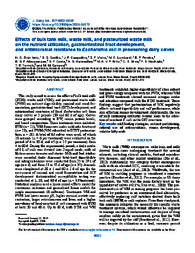Effects of bulk tank milk, waste milk, and pasteurized waste milk on the nutrient utilization, gastrointestinal tract development, and antimicrobial resistance to Escherichia coli in pre-weaned dairy calves.
Effects of bulk tank milk, waste milk, and pasteurized waste milk on the nutrient utilization, gastrointestinal tract development, and antimicrobial resistance to Escherichia coli in pre-weaned dairy calves.
Author(s): DINIZ NETO, H. C.; COELHO, S. G.; CAMPOLINA, J. P.; VIEIRA, S. F.; LOMBARDI, M. C.; PEREIRA, B. P.; ALBUQUERQUE, B. S. F.; COSTA, S. F.; GUIMARÃES, A. S.; BRITO, M. A. V. P.; SILVA, C. S.; MACHADO, F. S.; TOMICH, T. R.; CAMPOS, M. M.
Summary: This study aimed to assess the impact of bulk tank milk (BTM), waste milk (WM), and pasteurized waste milk (PWM) on nutrient digestibility, ruminal and cecal fermentation, gastrointestinal tract (GIT) development, and antimicrobial resistance of fecal Escherichia coli from dairy calves at 2 periods (30 and 60 d of age). Calves were grouped according to body weight, serum protein levels, and breed composition. Three treatments were included: BTM (n = 21), WM from cows under antibiotic treatment (n = 21), and PWM (waste milk submitted to high-temperature, short-time pasteurization; n = 21). A total of 63 calves were used, of which: 18 animals (n = 6 per treatment) evaluated in the period of 4 - 30 d and 45 (n = 15 per treatment) from 4 - 60 d. During the experimental period, a daily intake of 6 L of milk was divided into 2 equal meals, with ad libitum access to water and starter. Milk and feed intakes were recorded daily. Apparent total-tract digestibility and nitrogen balance were conducted from 25 to 29 d of age (n = 6) and from 53 to 57 d of age (n = 15). Animals were euthanized at 30 ± 1 and 60 ± 1 d of age for the assessment of ruminal and cecal fermentation and GIT development. Antimicrobial susceptibility testing was conducted at 1, 30, and 60 d of age (n = 15/treatment). Statistical analysis utilized a linear mixed-effects model for continuous outcomes and generalized linear models for single measurements (R software). Treatments WM and PWM had lower rumen pH, higher ruminal acetate concentration, larger reticulorumen and liver, and a higher prevalence of fecal-resistant E. coli compared with BTM at both 30 and 60 d. Up to 60 d, both BTM and WM treatments exhibited higher digestibility of ether extract and gross energy compared with the PWM, whereas WM and PWM treatments showed increased nitrogen intake and retention compared with the BTM. These findings suggest that pasteurization of waste milk negatively affects nutrient digestibility and calf performance, while also impacting rumen development. Additionally, the use of milk containing antibiotic residue leads to the selection of resistant E. coli in the GIT over time. Keywords: calf feeding strategies, nutrient partitioning, rational use of antimicrobials, rumen development, volatile fatty acids
Publication year: 2024
Types of publication: Journal article
Unit: Embrapa Dairy Cattle
Keywords: Bactéria, Bezerro Leiteiro, Gado Leiteiro, Leite
Observation
Some of Embrapa's publications are published as ePub files. To read them, use or download one of the following free software options to your computer or mobile device. Android: Google Play Books; IOS: iBooks; Windows and Linux: Calibre.
Access other publications
Access the Agricultural Research Database (BDPA) to consult Embrapa's full library collection and records.
Visit Embrapa Bookstore to purchase books and other publications sold by Embrapa.

